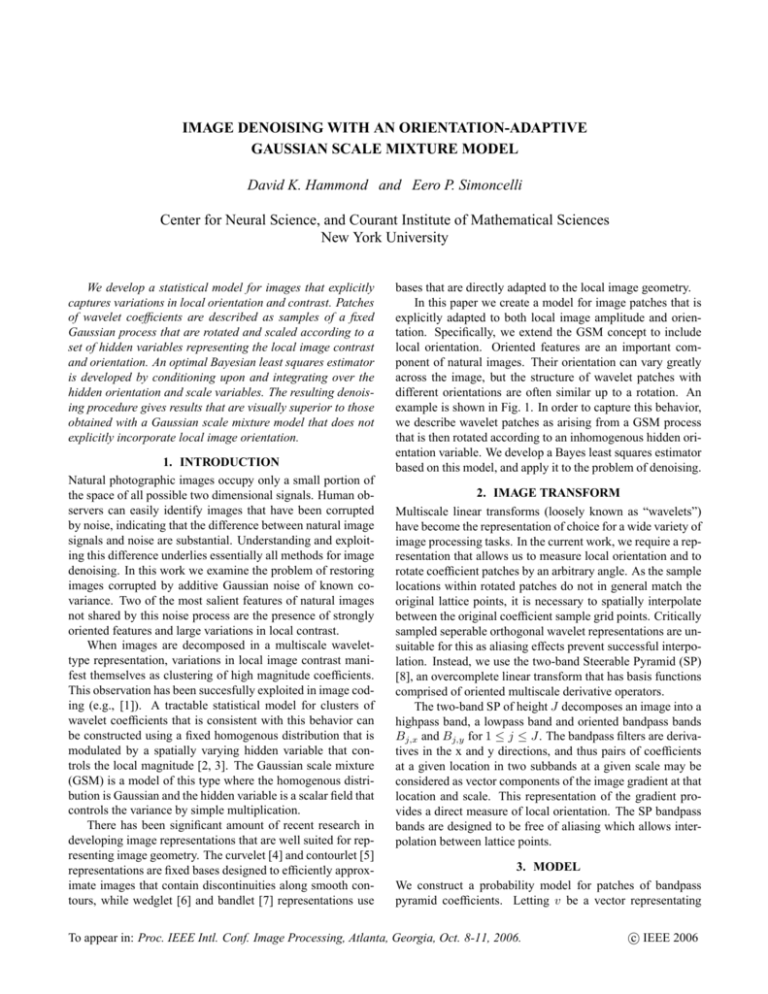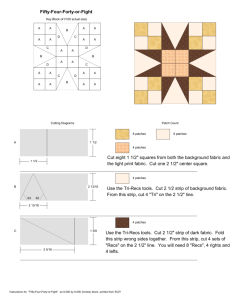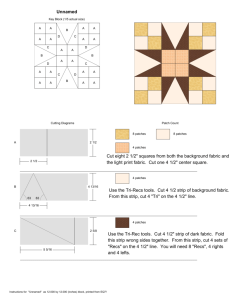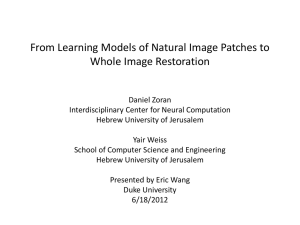IMAGE DENOISING WITH AN ORIENTATION
advertisement

IMAGE DENOISING WITH AN ORIENTATION-ADAPTIVE
GAUSSIAN SCALE MIXTURE MODEL
David K. Hammond and Eero P. Simoncelli
Center for Neural Science, and Courant Institute of Mathematical Sciences
New York University
We develop a statistical model for images that explicitly
captures variations in local orientation and contrast. Patches
of wavelet coefficients are described as samples of a fixed
Gaussian process that are rotated and scaled according to a
set of hidden variables representing the local image contrast
and orientation. An optimal Bayesian least squares estimator
is developed by conditioning upon and integrating over the
hidden orientation and scale variables. The resulting denoising procedure gives results that are visually superior to those
obtained with a Gaussian scale mixture model that does not
explicitly incorporate local image orientation.
1. INTRODUCTION
Natural photographic images occupy only a small portion of
the space of all possible two dimensional signals. Human observers can easily identify images that have been corrupted
by noise, indicating that the difference between natural image
signals and noise are substantial. Understanding and exploiting this difference underlies essentially all methods for image
denoising. In this work we examine the problem of restoring
images corrupted by additive Gaussian noise of known covariance. Two of the most salient features of natural images
not shared by this noise process are the presence of strongly
oriented features and large variations in local contrast.
When images are decomposed in a multiscale wavelettype representation, variations in local image contrast manifest themselves as clustering of high magnitude coefficients.
This observation has been succesfully exploited in image coding (e.g., [1]). A tractable statistical model for clusters of
wavelet coefficients that is consistent with this behavior can
be constructed using a fixed homogenous distribution that is
modulated by a spatially varying hidden variable that controls the local magnitude [2, 3]. The Gaussian scale mixture
(GSM) is a model of this type where the homogenous distribution is Gaussian and the hidden variable is a scalar field that
controls the variance by simple multiplication.
There has been significant amount of recent research in
developing image representations that are well suited for representing image geometry. The curvelet [4] and contourlet [5]
representations are fixed bases designed to efficiently approximate images that contain discontinuities along smooth contours, while wedglet [6] and bandlet [7] representations use
bases that are directly adapted to the local image geometry.
In this paper we create a model for image patches that is
explicitly adapted to both local image amplitude and orientation. Specifically, we extend the GSM concept to include
local orientation. Oriented features are an important component of natural images. Their orientation can vary greatly
across the image, but the structure of wavelet patches with
different orientations are often similar up to a rotation. An
example is shown in Fig. 1. In order to capture this behavior,
we describe wavelet patches as arising from a GSM process
that is then rotated according to an inhomogenous hidden orientation variable. We develop a Bayes least squares estimator
based on this model, and apply it to the problem of denoising.
2. IMAGE TRANSFORM
Multiscale linear transforms (loosely known as “wavelets”)
have become the representation of choice for a wide variety of
image processing tasks. In the current work, we require a representation that allows us to measure local orientation and to
rotate coefficient patches by an arbitrary angle. As the sample
locations within rotated patches do not in general match the
original lattice points, it is necessary to spatially interpolate
between the original coefficient sample grid points. Critically
sampled seperable orthogonal wavelet representations are unsuitable for this as aliasing effects prevent successful interpolation. Instead, we use the two-band Steerable Pyramid (SP)
[8], an overcomplete linear transform that has basis functions
comprised of oriented multiscale derivative operators.
The two-band SP of height J decomposes an image into a
highpass band, a lowpass band and oriented bandpass bands
Bj,x and Bj,y for 1 ≤ j ≤ J. The bandpass filters are derivatives in the x and y directions, and thus pairs of coefficients
at a given location in two subbands at a given scale may be
considered as vector components of the image gradient at that
location and scale. This representation of the gradient provides a direct measure of local orientation. The SP bandpass
bands are designed to be free of aliasing which allows interpolation between lattice points.
3. MODEL
We construct a probability model for patches of bandpass
pyramid coefficients. Letting v be a vector representating
To appear in: Proc. IEEE Intl. Conf. Image Processing, Atlanta, Georgia, Oct. 8-11, 2006.
c IEEE 2006
Fraction of Total Variance
0.3
0.2
0.1
0
0
10
20
30
40
Eigenvalue number
50
Fig. 2. Normalized eigenvalues of covariance matrix estimated from coefficient patches drawn from single scale of
the pyramid representation of an example image (“peppers”).
Dashed curve corresponds to raw patches, and solid curve to
patches rotated according to dominant orientation.
Fig. 1. Left: Image with two strongly oriented patches indicated. Right: coefficients for each patch at one scale of a twoband steerable pyramid, displayed as vector fields. Patches
are similar up to rotation.
statistics, we can examine the eigenvalues of the covariance
matrix. Figure 2 shows the eigenvalues of the covariance matrix formed from the sample outer products of vectorized 5x5
patches of 2-band SP coefficients drawn directly from an example image, compared with that computed from patches that
are rotated to align the dominant local orientation with the
horizontal axis. The curve for the rotated patches clearly indicates that energy is more concentrated in the first few eigenvalues, suggesting that behavior of the rotated patches is more
homogeneous.
such a patch, we set
v=
0.4
√
zR(θ)u
where z and θ are hidden scalar variables, R(θ) is a linear
spatial rotation operator and u is a zero mean multivariate
Gaussian random variable with covariance C0 . We assume
the hidden variables z and θ are independent of each other
and of u. Thus, the full density of v corresponds to an infinite mixture of Gaussians, with the mixture determined by
the density of the hidden variables. We assume a uniform distribution on [0, 2π) for pθ (θ), and following [9, 10] place a
non-informative Jeffrey’s pseudoprior pz (z) ∝ z1 on the multiplier z, truncated to z ∈ [zmin , zmax ] with same bounds as
in [10].
Note that when conditioned on fixed values of the hidden
variables z and θ, the patch v is distributed as a zero mean
multivariate Gaussian with covariance adapted according to
the local amplitude and orientation and written as
4. ESTIMATING MODEL PARAMETERS
The model is specified by knowledge of the covariance matrix C(θ), or equivalently, of C0 and R(θ). In this work we
estimate C(θ) directly from the noisy data, by estimating the
orientation of each patch, spatially rotating (and interpolating) the patches contents, and then computing the covariance
of these rotated patches. Each of these steps is described in
the following subsections.
T
zC(θ) = zR(θ)C0 R(θ)
In this paper we use 5x5 patches augmented with one pair
of “parent” coefficients from the immediately coarser subband, to include some cross-scale interaction.
Attempting to undo the action of the multiplier z by dividing each patch by an estimate of the hidden variable at its location yields patches with statistical properties much closer to
Gaussian [2]. Thus, the variations of the local contrast can be
captured by the hidden multiplier, and when this is removed
by division the statistics of the remaining process are more
homogenous.
One may similarily attempt to undo the effect of the hidden orientation by rotating the content of image wavelet patches
according to an estimate of the local orientation. As a measure of the effectiveness of the model in capturing local image
2
4.1. Neighborhood Orientation
An m×m patch of two-band SP coefficients v may be considered as a collection of m2 gradient vectors hi for i = 1...m2 .
We define the neighborhood orientation φ for the patch as the
angle of the unit vector k(φ) = (cos(φ), sin(φ))T that maximizes the sum of squares of inner products
2
T
2
Σm
i=1 (k(φ) hi ) .
This is equivalent to the orientation of the eigenvector corresponding to the largest eigenvalue of the 2 × 2 Orientation
Response Matrix M = Σhi hTi . Setting hi = (xi , yi )T , we
have
1
φ = 6 2Σxi yi , Σ(x2i − yi2 ) ,
2
where 6 indicates the angle of the vector whose components
are specified by the two arguments.
covariance for the subband noise can be computed from the
pyramid decomposition of the power spectra of the noise process in the pixel domain (as in [10]).
Given a patch of noisy coefficient data w, we write w =
v +n where v is the original image patch we wish to estimate,
and n is a zero mean Gaussian with covariance Cn .
The Bayes least squares estimator is then
Z
v̂ = vp(v|w)dv
4.2. Rotation of Patches
We describe a patch v located at position (m,n) of the j’th
gradient band by
vp (r, s) = Bj,p (m + r, n + s)
for p = {x, y}. Resampling the x and y components along a
coordinate system rotated by θ gives
Sp (r, s) = Bj,p (m + r sin θ + s cos θ, n + r cos θ − s sin θ)
These vector components must then be transformed together
as a vectors, we thus define R(θ)v by
Analogous to the method of [10], we compute this first by
introducing and integrating over the hidden variables θ and z
Z ZZ
v̂ = v
p(v, z, θ|w)dzdθ dv
Z
ZZ
=
p(z, θ|w)
vp(v|w, z, θ)dv
dzdθ
(R(θ)v)x = cos θSx + sin θSy
(R(θ)v)y = − sin θSx + cos θSy
The resampling requires values for the bands Bj,x and
Bj,y at locations between the regular sample lattice points.
We first upsample each band by a factor of 2Uf in each direction by padding the fourier transform with zeros and taking the inverse fourier transform. We then perform bilinear
interpolation from the four nearest upsampled lattice points.
Results presented in this paper use Uf = 4.
As v is Gaussian with covariance zC(θ) when conditioned
on z and θ, the inner integral over v is a standard linear (Wiener)
estimate:
Z
v̂(w; z, θ) = vp(v|w, z, θ)dv = zC(θ)(Cn + zC(θ))−1 w
4.3. Estimation of C(θ)
Our model describes an image patch v corrupted with additive
Gaussian noise by
√
w = zR(φ)u + n
v̂ is thus a weighted integral of these Wiener estimates. By
Bayes rule we have
p(z, θ|w) =
where n is a sample from the zero mean Gaussian noise process with known covariance Cn .
The rotator variables φ are unknown, and are estimated
by computing the neighborhood orientation φ∗ of the noisy
patch. Under the assumption that the noise process is rotationally invariant and that z, u and n are independent, we
have
p(w|z, θ)p(z, θ)
p(w)
When conditioned on z and θ, w is a zero mean Gaussian with
covariance zC(θ) + Cn . Transforming the integral over z to
the log domain by setting y = log(z) yields
1
v̂ =
N
ZZ
exp(− 12 wT (ey C(θ) + Cn )−1 w)
v̂(w; z, θ)dθdy
|ey C(θ) + Cn |1/2
with appropriate normalization constant N . This procedure
gives an estimate of the entire patch; in practice we estimate
each coefficient using a patch centered on it, taking the center
coefficient. These integrals are computed as simple double
sums by discretizing log(z) and θ to a finite number of points.
Results shown in this paper use 13 points for log z and 16 for
θ. The scalar highpass residual is denoised using the GSM
procedure described in [10], while the lowpass band is left
unchanged.
E[R(θ − φ∗ )v(R(θ − φ∗ )v)T ]
= E[z]E[R(θ)u(R(θ)u)T ] + Cn
= C(θ) + Cn
where we assume without loss of generality that E[z]=1. Note
that φ∗ is different for every patch.
We estimate C(θ) by forming the average outer product
of rotated patches and subtracting Cn . To ensure positive definiteness we diagonalize the estimate and replace all negative
eigenvalues by the smallest positive eigenvalue.
6. RESULTS
Figure 3 shows a denoising example, using 5 × 5 patches including parent and SP height 3. The lower right image is
denoised using the model described above. The lower left
image is denoised using the GSM model of [10] with two SP
bands, which is similar to the current method without adaptation to orientation. The best results in [10] were obtained
using an 8-band SP, and are comparable or slightly better than
5. DENOISING ALGORITHM
We perform denoising in the SP coefficient domain by decomposing the noisy image, denoising the subbands and then
inverting the SP transform. We assume the noise is additive,
Gaussian and stationary with known covariance. Each subband contains noise filtered by the SP basis functions; the
3
Two band GSM
Current method
Barbara
29.19
29.83
Lena
31.51
31.74
Peppers
31.56
31.69
Boats
30.06
30.05
Table 1. Denoising results in PSNR for 512×512 test images
with gaussian white noise with σ = 20. Noisy images all have
PSNR=22.10
of estimating C(θ) and a more systematic exploration of the
effects of neighborhood size.
Finally, as in previous work [10], we do not currently
make use of the full global model implied by our local description (we ignore the overlap of the patches, computing
independent estimates of each coefficient based solely on its
surrounding patch). We do not include any description of the
spatial structure of the hidden orientation variables. Incorporating such effects is difficult, but is likely to lead to substantial additional improvements in performance.
8. REFERENCES
Fig. 3. Upper left: Cropped original image. Upper right:
image with added white Gaussian noise with σ = 40 (PSNR
= 16.08). Lower left: denoised with two-band GSM model
(PSNR = 25.60) (see [10]). Lower right: denoised with
orientation-adapted two-band GSM. (PSNR=26.22)
the orientation-adapted GSM results presented here. Note
that the edges in the image denoised with the orientationadapted method are sharper, and suffer less from blockiness
on oblique edges. Table 1 compares PSNR results for several
test images.
7. DISCUSSION
We’ve introduced a statistical model for local patches of wavelet
coefficients using an infinite mixture of Gaussians, in which
the mixture depends on two hidden variables representing local amplitude and local orientation. We’ve demonstrated use
of this new model in denoising, comparing its performance
with previous models that utilize only a single hidden amplitude variable [10]. We find that the addition of the orientation
variable leads to improvements in PSNR, as well as visual
appearance. More generally, the orientation variable allows
efficient representation of locally oriented structures which
should render the model useful for other applications such as
compression, restoration, inpainting, or synthesis.
The current denoising method is well suited for capturing
oriented image content; however in regions of the image that
do not have a strong dominant orientation such as constant or
nonoriented texture areas the method produces spurious oriented artifacts. Preliminary work indicates that these artifacts
may be supressed by adapting the model to the local ”orientedness” of the signal. We are also pursuing a number of
other potential improvements, including alternative methods
4
[1] J M Shapiro, “Embedded image coding using zerotrees of
wavelet coefficients,” IEEE Trans. on Signal Processing, vol.
41, no. 12, pp. 3445–62, December 1993.
[2] M J Wainwright and E P Simoncelli, “Scale mixtures of Gaussians and the statistics of natural images,” in Adv. Neural Information Processing Systems (NIPS*99), S. A. Solla, T. K. Leen,
and K.-R. Müller, Eds., Cambridge, MA, May 2000, vol. 12,
pp. 855–861, MIT Press.
[3] M K Mihçak, I Kozintsev, K Ramchandran, and P Moulin,
“Low-complexity image denoising based on statistical modeling of wavelet coefficients,” IEEE Signal Processing Letters,
vol. 6, no. 12, pp. 300–303, December 1999.
[4] E. Candés and D Donoho, “Curvelets : A surprisingly eddective nonadaptive represenentation of objects with edges,” in
Curves and Surfaces fitting, L L Schumaker, A Cohen and C
Rabut, eds, Vandebuilt University Press, 1999.
[5] M N Do and M Vetterli, “The contourlet transform: an efficient
directional multiresolution image representation,” IEEE Trans.
on Image Processing, vol. 14, no. 12, pp. 2091–2106, 2005.
[6] J K Romberg, M B Wakin, and R G Baraniuk, “Multiscale geometric image processing,” in Proceedings of the SPIE, 2003,
vol. 5150, pp. 1265–1272.
[7] Erwan Le Pennec and Stéphane Mallat, “Sparse geometric image representations with bandlets,” IEEE Trans. on Image Processing, vol. 14, no. 4, pp. 423–438, 2005.
[8] E P Simoncelli and W T Freeman, “The steerable pyramid: A
flexible architecture for multi-scale derivative computation,” in
2nd Int’l Conf on Image Proc, Washington, DC, October 1995,
vol. III, pp. 444–447.
[9] M Figueiredo and R Nowak, “Wavelet-based image estimation: An empirical Bayes approach using Jeffrey’s noninformative prior,” IEEE Trans. Image Processing, vol. 10, no. 9,
pp. 1322–1331, September 2001.
[10] J Portilla, V Strela, M Wainwright, and E P Simoncelli, “Image
denoising using a scale mixture of Gaussians in the wavelet
domain,” IEEE Trans. Image Processing, vol. 12, no. 11, pp.
1338–1351, November 2003.




